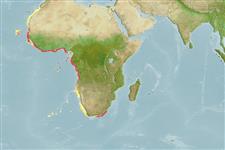>
Ateleopodiformes (Jellynose fishes) >
Ateleopodidae (Jellynose fishes)
Eponymy: Professor Dr Isao Ijima (1861–1921) was Professor of Zoology at Science College, Imperial University of Tokyo (1885–1921) from where he had graduated (1881). [...] Dr Etienne Loppé (1883–1954) was a physician who qualified in Paris. [...] (Ref. 128868), visit book page.
Environment: milieu / climate zone / depth range / distribution range
นิเวศวิทยา
เกี่ยวกับทะเล,น้ำเค็ม สัตว์หน้าดินในเขตน้ำลึก; ระดับความลึก 200 - 998 m (Ref. 6550). Deep-water; 31°N - 35°S
Eastern Atlantic: Morocco to South Africa.
ขนาด / น้ำหนัก / Age
Maturity: Lm ? range ? - ? cm
Max length : 200 cm TL เพศผู้/กระเทย; (Ref. 36731)
Short description
เครื่องมือที่ใช้ในการแยกชนิดสัตว์,สิ่งมีชีวิตออกจากกัน | สัณฐานวิทยา | ความยาวต่างๆ
เงี่ยงครีบหลัง (รวม) : 0; ก้านครีบอ่อนที่หาง (รวม) : 9 - 10; เงี่ยงครีบก้น: 0; ก้านครีบอ่อนที่ก้น: 78 - 85. Dark brown to black in color, lighter below; pelvic ray and fold of skin at angle of mouth pale (Ref. 5528).
Inhabits upper slopes (Ref. 27121). Feeds on ophiuroids and fishes (Ref. 6717).
Life cycle and mating behavior
วัยเจริญพันธุ์ | การสืบพันธุ์ | การวางไข่ | เซลสืบพันธ์ของเพศเมีย(ไข่) | ความดกของไข่ | ตัวอ่อน
Costa, M.J. and J.-C. Quéro, 1990. Ateleopodidae. p. 644-645. In J.C. Quero, J.C. Hureau, C. Karrer, A. Post and L. Saldanha (eds.) Check-list of the fishes of the eastern tropical Atlantic (CLOFETA). JNICT, Lisbon; SEI, Paris; and UNESCO, Paris. Vol. 2. (Ref. 6550)
IUCN Red List Status (Ref. 130435: Version 2024-1)
Threat to humans
Harmless
Human uses
เครื่องมือ
Special reports
Download XML
แหล่งที่มาจากอินเตอร์เน็ต
Estimates based on models
Preferred temperature (Ref.
123201): 8.7 - 13.7, mean 10.7 °C (based on 21 cells).
Phylogenetic diversity index (Ref.
82804): PD
50 = 0.5315 [Uniqueness, from 0.5 = low to 2.0 = high].
Bayesian length-weight: a=0.00389 (0.00180 - 0.00842), b=3.12 (2.94 - 3.30), in cm total length, based on all LWR estimates for this body shape (Ref.
93245).
ระดับชั้นอาหาร (Ref.
69278): 4.3 ±0.71 se; based on food items.
Fishing Vulnerability (Ref.
59153): Very high vulnerability (90 of 100).
